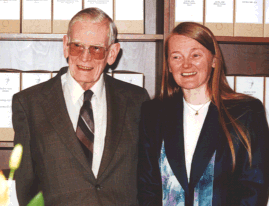Ralph Brazelton Peck

Ralph B. Peck with NGI Director Suzanne Lacasse
at the opening of Ralph B. Peck Library at NGI (2000)
|
World Wide Web of Geotechnical Engineers - Hall of Fame |
Ralph Brazelton Peck

Ralph B. Peck with NGI Director Suzanne Lacasse
at the opening of Ralph B. Peck Library at NGI (2000)
Peck in a nutshell:
Ralph Peck was born on June 23, 1912 in Winnipeg, Manitoba, Canada to O.K. and Ethel Peck. The family later moved to the United States when young Peck was six years old. He received the degree of Civil Engineer from Rensselaer Polytechnic Institute in 1934, and was awarded a three year fellowship for graduate work. Most of his graduate work was in structures with minors in mathematics and geology. On June 14, 1937 Peck married Marjorie Truby. Also, that same day he completed his graduate work and obtained a Doctor of Civil Engineering degree. From that point on he became a world leader in geotechnical engineering and his influence has reached many people. During his career Peck has authored over 200 publications and co-author many more articles on geotechnical engineering.
Early Practice:
Peck initially believed his field of study was in structures, but he later became focused on geotechnical engineering. Dr. Peck had the opportunity to work with Karl Terzaghi early on in his career. On several occasion Terzaghi gave Peck advise on soil mechanics and indeed influenced his career. Peck and Terzaghi have collaborated on several manuscripts and their work has been instrumental in soil mechanics.
Peck’s Legacy:
Peck spent three decades at the University of Illinois. During that time he influenced an unimaginable amount of students. He was also very influential as a consulting engineer. There he helped pioneer practices in foundations, ore storage facilities, tunnel projects, dams, and dikes. The Dead Sea project was one of Peck’s pioneering works. He later said that "There is no question that the Dead Sea Job was the most high-flying activity that I ever got involved in."
Awards and Recognition:
During his professional career, Dr. Peck received many awards, including:
- The Norman Medal by the American Society of Civil Engineers, 1944
- The Wellington prize by the ASCE, 1965
- The Karl Terzaghi Award, 1969
- Participated in numerous ASCE committees and served as officer on several occasions.
- President of the International Society of Soil Mechanics and Foundation Engineering from 1969 to 1973.
- The National Medal of Science, presented by President Ford in 1975
- The Washington Award
- Numerous technical, professional, and honorary societies